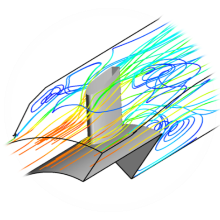Experimental research of axial diffuser flows
The axial diffuser test rig at ITSM allows a detailed investigation of the flow in diffusers. The flow parameters that are decisive for the performance of the diffuser, such as total pressure profile, swirl, Mach number and tip jet flow, can be set independently and specifically to represent the conditions at the outlet of gas turbine stages. In addition, the rig is flexibly designed to allow geometry variations to be implemented quickly and easily. Accompanying the experimental investigations, numerical flow simulations are conducted in order to derive design guidelines and measures for the design of diffusers with high efficiency and a wide, safely usable operating range.
Numerical investigation of axial diffuser flows
Accompanying the experimental investigations on the axial diffuser test rig, numerical fluid simulations are conducted in order to derive design guidelines and measures for the design of diffusers with high efficiency and a wide, safely usable operating range. Particularly in part-load operation with significantly detached flow, calculations using CFD is a major challenge. Scale-resolved turbulence models are used, and the calculation result can then be validated with measurement data.
Research on flows in axial-radial diffusers
The advantage of using axial-radial diffusers over axial diffusers is their more compact design. Due to the axial-radial flow deflection in combination with a single-flow downstream casing, an asymmetric flow distribution is formed in the diffuser. This, in combination with the varying downstream conditions of the last blade row, leads to large-scale fluctuating flow separations, which under certain circumstances can excite the blades of the last turbine stage to oscillate. The experimental investigations at the ITSM diffuser test rig are accompanied by extensive numerical simulations in order, on the one hand, to analyze specific effects such as the flow asymmetry and stabilization effects of the tip jet flow for different operating conditions and, on the other hand, to improve the quality of the numerical prediction of flow separations.





